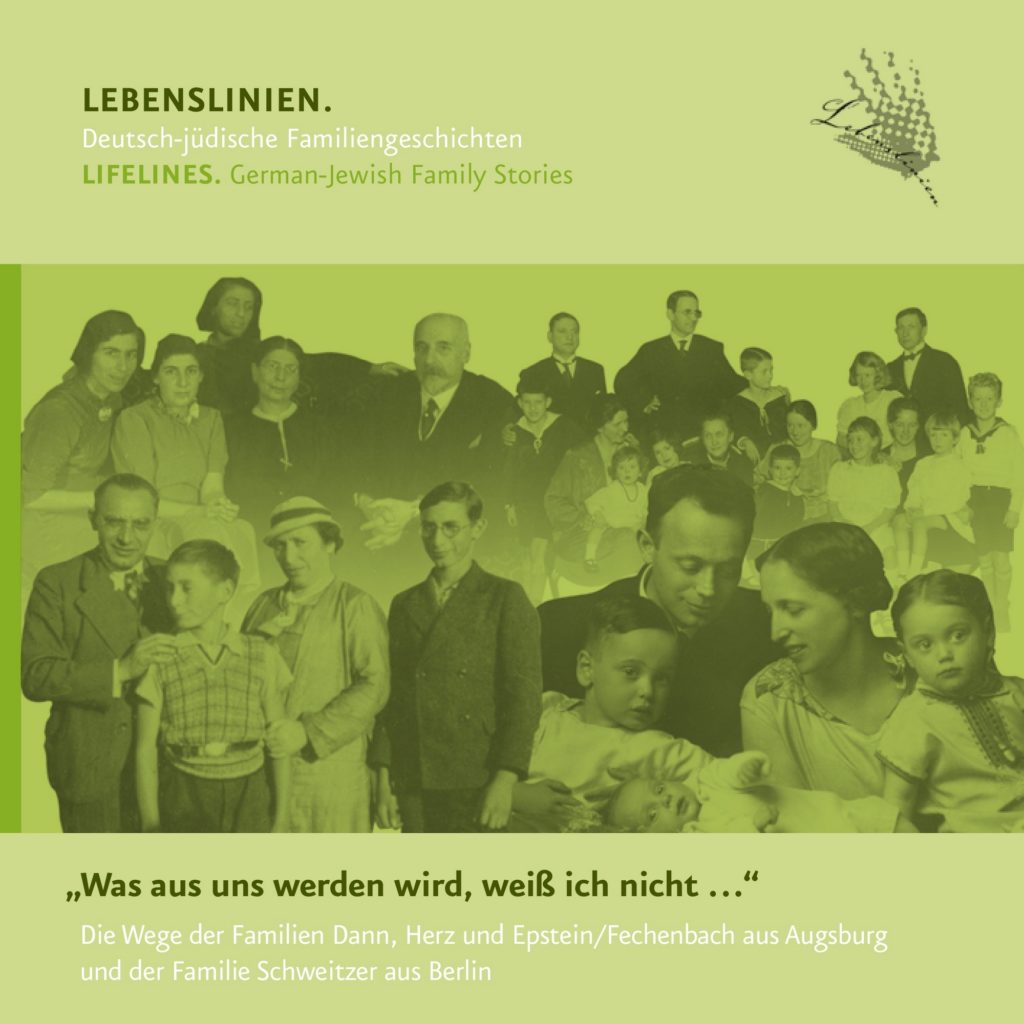German-jewish family stories
The eyewitness project LIFELINES was initiated by the Jewish Museum Augsburg Swabia and the Sensemble Theater in 2002 and for many years consisted of several subprojects.
The first part was a public matinee featuring a Jew from Augsburg or elsewhere in Germany who was persecuted and driven into exile under National Socialism. In the course of the matinee, the eyewitness’s life was narrated and examined. The second part was a series of workshops in which secondary school students were able to ask the eyewitness questions about his or her experiences. These workshops were filmed and edited to create the third part of the LIFELINES project, namely interactive DVDs. With these educational DVDs, school classes could review the biography of our LIFELINES guest and recreate the encounter with him or her anywhere and anytime.
The fourth component was a publication that assembled for later reading and dissemination all the information collected about the LIFELINES guest.
The last LIFELINES with a first-generation witness took place in November 2015. Walter Jacob (Pittsburgh, USA), the son of Ernst Jacob, the last prewar rabbi of the Augsburg community, recounted how his family fled Germany under National Socialism, emigrating first to England and then to the USA.
Generation change
Sadly, most first-generation eyewitness have now passed away, and those still living are rarely able to make the trip to Germany. That’s why we relaunched our eyewitness project in 2019 as LIFELINES 2.0, a new series focusing the second and third generations of survivors’ families.
Orders:
0821-51 36 58
office@jmaugsburg.de
-
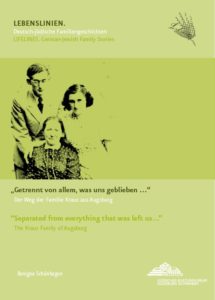 Benigna Schönhagen, LIFELINES. German-Jewish Family Stories: “Apart from all that has remained…” The Kraus Family of Augsburg, Volume 1, published by Benigna Schönhagen for the Jewish Culture Museum Augsburg-Swabia, Augsburg 2009, 88 pages, color and b/w photos, texts in German and English.
Benigna Schönhagen, LIFELINES. German-Jewish Family Stories: “Apart from all that has remained…” The Kraus Family of Augsburg, Volume 1, published by Benigna Schönhagen for the Jewish Culture Museum Augsburg-Swabia, Augsburg 2009, 88 pages, color and b/w photos, texts in German and English. ISBN: 978-3-9812246-1-0.
10.00 € plus postage and handling.The first volume was published following the Sunday matinee of November 16th 2008, and is entitled “Apart from all that has remained…” The Kraus Family of Augsburg. This 94-page, soft-cover book was authored by Museum Director Dr. Benigna Schönhagen and contains numerous documents and photos as well as an in-depth interview with eyewitness Liora Se’ewi of Jerusalem plus an introduction to the Nazi race laws by Helmut Hartmann.
-
 Monika Müller, LIFELINES. German-Jewish Family Stories: “The trauma of exile is indelible…” Paths Taken by the Aub Family of Augsburg, Volume 2, published by Benigna Schönhagen for the Jewish Culture Museum Augsburg-Swabia, Augsburg 2009, 88 pages, color and b/w photos, texts in German and English.
Monika Müller, LIFELINES. German-Jewish Family Stories: “The trauma of exile is indelible…” Paths Taken by the Aub Family of Augsburg, Volume 2, published by Benigna Schönhagen for the Jewish Culture Museum Augsburg-Swabia, Augsburg 2009, 88 pages, color and b/w photos, texts in German and English.ISBN: 978-3-9812246-3-4
10.00 € plus postage & handlingThe second volume tells the story of the Aub family of Augsburg and describes the discrimination and social exclusion of the Jewish-Christian family by the Nazi regime. Forced to separate by the emigration of their Jewish father, his story of lonely exile in Sierra Leone and Jamaica is depicted as well as the dangerous life led by his wife and their three children in the Nazi state. The family was finally reunited after the end of WWII and could begin a new life together in Jamaica. Numerous photos and contemporary documents graphically depict the family’s fate and animate to read on.
-
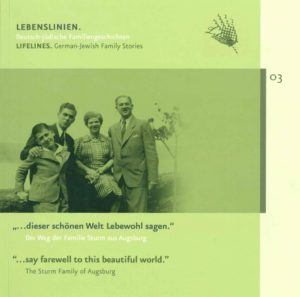 Souzana Hazan, LIFELINES. German-Jewish Family Stories: “…say farewell to this beautiful world.” The Sturm Family of Augsburg, Volume 3, published by Benigna Schönhagen for the Jewish Culture Museum Augsburg-Swabia, Augsburg 2010, 88 pages, color and b/w photos, texts in German and English.
Souzana Hazan, LIFELINES. German-Jewish Family Stories: “…say farewell to this beautiful world.” The Sturm Family of Augsburg, Volume 3, published by Benigna Schönhagen for the Jewish Culture Museum Augsburg-Swabia, Augsburg 2010, 88 pages, color and b/w photos, texts in German and English.ISBN: 978-3-9812246-7-2
10.00 € plus postage & handlingThe third volume tells the story of the Sturm family of Augsburg, the topic of our LIFELINES 2010 eyewitness project, the story of a German-Jewish family that gradually lost its livelihood after the Nazis took power. Only part of the family was able to flee to safe havens abroad. For those left behind the Nazi regime took away all possibilities for a humane way of life. When the order for deportation “to the East” finally came, they resisted by committing suicide. Each family member who emigrated came to grips with his/her experiences during the Nazi era quite individually. Numerous photos and contemporary documents graphically depict the family’s fate and animate to read on.
-
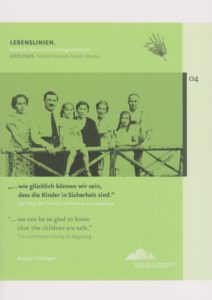 Benigna Schönhagen, LIFELINES. German-Jewish Family Stories: “…we can be so glad to know that the children are safe.” The Lamfromm Family of Augsburg, Volume 4, published by Benigna Schönhagen for the Jewish Culture Museum Augsburg-Swabia, Augsburg 2011, 91 pages, color and b/w photos, texts in German and English
Benigna Schönhagen, LIFELINES. German-Jewish Family Stories: “…we can be so glad to know that the children are safe.” The Lamfromm Family of Augsburg, Volume 4, published by Benigna Schönhagen for the Jewish Culture Museum Augsburg-Swabia, Augsburg 2011, 91 pages, color and b/w photos, texts in German and EnglishISBN: 978-3-9812246-8-9
10.00 € plus postage & handlingThe fourth volume deals with the fate of the Lamfromm family of which contemporary witness Eva Labby neé Lamfromm gave account in 2011. Her family had been an economically successful and greatly respected part of Augsburg’s society. Yet, in 1937, eight-year-old Eva left Germany forever together with her parents and sisters. Due to the early emigration date, the family was able to plan and prepare for their departure. While being spared of the existential hardships of Jewish people emigrating at a later date, they still had to bear the loss of their entire financial capital as well as, hardest of all, the loss of relatives and friends who died in Theresienstadt or Auschwitz. Nevertheless, due to their determination and commitment, the Lamfromm family was able to build an internationally successful company in the United States and hence represents an example for the chances offered to Jewish immigrants in the USA.
-
 Monika Müller, LIFELINES. German-Jewish Family Stories: “It’s a cruel hand we’ve been dealt.” The Einstein Family of Augsburg-Kriegshaber, Volume 5, published by Benigna Schönhagen for the Jewish Culture Museum Augsburg-Swabia, Augsburg 2012, 96 pages, color and b/w photos, texts in German and English
Monika Müller, LIFELINES. German-Jewish Family Stories: “It’s a cruel hand we’ve been dealt.” The Einstein Family of Augsburg-Kriegshaber, Volume 5, published by Benigna Schönhagen for the Jewish Culture Museum Augsburg-Swabia, Augsburg 2012, 96 pages, color and b/w photos, texts in German and EnglishISBN: 978-3-9814958-1-2
10.00 € plus postage & handlingContemporary witness Liese Fischer neé Einstein from Silver Spring / Maryland visited Augsburg in November 2012 and gave account of her family’s fate. She was born in 1925 to an esteemed Jewish family. Her father Moritz Einstein conducted, together with five of his seven brothers, the cattle trade “Gebrüder Einstein” (Einstein Brothers) in Kriegshaber, one of the preeminent livestock businesses in Swabia up to the era of National Socialism. After the National Socialist accession to power, Liese Fischer’s parents were still so respected in their personal milieu in spite of the governmental discrimination that they did not feel seriously threatened. The events of November 1938 made them realize their threatened existence. However, despite intense efforts they did not succeed in finding an emigration country willing to admit the whole family. They could only bring their children Liese and Siegbert to safety in Great Britain by means of the Refugee Children Movement in July 1939. Moritz Einstein and his wife were deported to Auschwitz in March 1943 and murdered there. After the war, Liese Einstein went to the USA, where a new life began for her.
-
 Benigna Schönhagen, LIFELINES. German-Jewish Family Stories: „… and then we will take our leave of Augsburg and Germany.“ The Stern Family of Augsburg, Volume 6, published by Benigna Schönhagen for the Jewish Culture Museum Augsburg-Swabia, Augsburg 2013, 104 pages, color and b/w photos, texts in German and English
Benigna Schönhagen, LIFELINES. German-Jewish Family Stories: „… and then we will take our leave of Augsburg and Germany.“ The Stern Family of Augsburg, Volume 6, published by Benigna Schönhagen for the Jewish Culture Museum Augsburg-Swabia, Augsburg 2013, 104 pages, color and b/w photos, texts in German and EnglishISBN: 978-3-9814958-5-0
10.00 € plus postage & handlingThe Stern family from Augsburg had lived in the city since 1902. Henry Stern, who was our guest at LIFELINES in 2013, was born in 1927. As Heinz Markus Stern, as he was called until he emigrated, he grew up together with his older brother Manfred at Mozartstraße 7 in the upscale, Wilhelminian-style Beethovenviertel. Until the transfer of power to the National Socialists, Manfred and Heinz experienced a carefree childhood. After 1933, this gradually changed. Like all Jews, the Sterns increasingly felt the discrimination and disenfranchisement of the Nazi regime. In November 1938, Heinz and Manfred Stern saw their father arrested in connection with the pogrom and taken to Dachau concentration camp. After his release, the Sterns immediately sought the possibility of emigration. In July 1939, the parents were finally able to send Manfred to London on a Kindertransport. Shortly thereafter, they were also able to flee to Great Britain with Heinz. From there, the family emigrated to the USA in 1940.
-
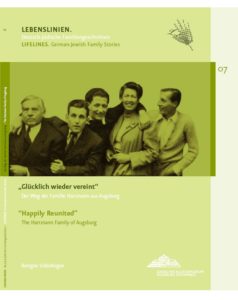 Benigna Schönhagen, “Happily Reunited” The Hartmann Family of Augsburg, published by Benigna Schönhagen for the Jewish Culture Museum Augsburg-Swabia, Augsburg 2014, 120 pages, color and b/w photos, texts in German and English
Benigna Schönhagen, “Happily Reunited” The Hartmann Family of Augsburg, published by Benigna Schönhagen for the Jewish Culture Museum Augsburg-Swabia, Augsburg 2014, 120 pages, color and b/w photos, texts in German and EnglishISBN: 978-3-9814958-7-4
10.00 € plus postage & handlingThe family history of the Hartmanns under National Socialism shines a light on the persecution of persons of partial Jewish ancestry. For a long time, the ordeal faced by these survivors was overshadowed by the horrors of mass murder. Indeed, so-called Mischlinge (“half-breeds”) felt the brunt of Nazi persecution only relatively late. Yet they too became familiar with humiliating marginalization, economic disadvantages and life plans disrupted or destroyed. For children and adolescents in particular, the sudden classification as a “half-Jew” often led to lasting identity conflicts. The attempts of the Hartmann paterfamilias to hide his wife’s Jewish ancestry, even to have her declared as “of German blood,” demonstrate the absurdity of Nazi racial categories. Despite threats of deportation and forced labor, the Hartmanns all survived and were “happily reunited” in the summer of 1945. Afterwards, family members adopted very different approaches to processing what they had been through. Helmut Hartmann, for one, succeeded in turning his negative experiences into a strength and grew from a youth who belonged nowhere into an adult with a gift for mediation, a reconciler and uniter of different groups.
-
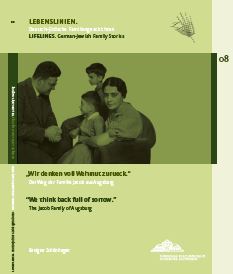 Benigna Schönhagen, LIFELINES. German-Jewish Family Stories: „We think back full of sorrow” The Jacob Family of Augsburg, Volume 8, published by Benigna Schönhagen for the Jewish Cultural Museum Augsburg-Swabia, Augsburg 2015, 116 pages, texts in German and English, colour and b/w photos.
Benigna Schönhagen, LIFELINES. German-Jewish Family Stories: „We think back full of sorrow” The Jacob Family of Augsburg, Volume 8, published by Benigna Schönhagen for the Jewish Cultural Museum Augsburg-Swabia, Augsburg 2015, 116 pages, texts in German and English, colour and b/w photos.ISBN: 978-3-9814958-9-8
10.00 € plus postage & handlingThe eighth volume of the LIFELINES series presents the story of the Jacobs, a family with a long rabbinical tradition. Benno Jacob (1862–1945) is regarded as one of the great German-Jewish Bible scholars of the twentieth century, with an influence that survives to this day. His son Ernst Jacob (1899–1974) was the last prewar rabbi of the Augsburg community, continued to lead his congregation under National Socialism and fled with his family only at the last possible moment. Born in Augsburg in 1930, Ernst’s son Walter became a rabbi as well, carrying the Jacob rabbinical line into the sixteenth generation. An influential Liberal rabbi of many decades in the USA, Walter Jacob has been working since the 1990s to reestablish Liberal Judaism in Germany.
-
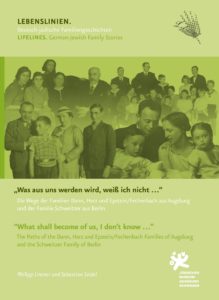 Philipp Lintner and Sebastian Seidel, “What shall become of us, I don’t know …” The Paths of the Dann, Herz and Epstein/Fechenbach Families of Augsburg and the Schweitzer Family of Berlin, published by Barbara Staudinger for the Jewish Museum Augsburg Swabia, Augsburg 2020, 212 pages, texts in german and english, with numerous color and b/w photographs and documents.
Philipp Lintner and Sebastian Seidel, “What shall become of us, I don’t know …” The Paths of the Dann, Herz and Epstein/Fechenbach Families of Augsburg and the Schweitzer Family of Berlin, published by Barbara Staudinger for the Jewish Museum Augsburg Swabia, Augsburg 2020, 212 pages, texts in german and english, with numerous color and b/w photographs and documents.ISBN: 978-3-9816601-3-5
15.00 € plus postage and handlingThe ninth volume of the LIFELINES series documents the histories of the Danns, Herzes and Epstein/Fechenbachs of Augsburg and the Schweitzers of Berlin, retracing the paths of these four Jewish families from the nineteenth century to the present. An eyewitness from each family visited Augsburg as a LIFELINES guest between 2002 and 2008, but the museum produced no publication about these families until now. This volume thus fills a significant gap in our publications and provides an apt conclusion to the original LIFELINES series, which has been continued since 2019 as LIFELINES 2.0.
